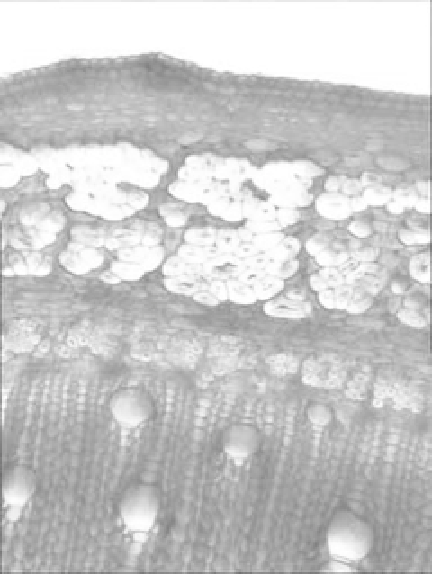Agriculture Reference
In-Depth Information
The dioecious varieties
In effect, a variety responding to a night length
of 8 h, for example, will finish its growth earlier
in Italy than in France or in Sweden.
Certain breeders have therefore suggested
moving the production of seed southwards,
away from the zones of cultivation, in order to
produce late-flowering varieties that will have
a higher hurd and fibre yield. As indicated pre-
viously, the lateness of flowering can still pose
problems with regard to harvestability, and
this must be limited.
Today, those varieties developed and culti-
vated in France reach full flowering (at the lati-
tude of Le Mans) between 31 July and 15
August. Seed of the earliest varieties will reach
physiological maturity between 15 and 25
September.
Today, across Europe, few breeders work on
dioecious varieties. We know only of the
Hungarian and Serbian programmes that work
exclusively with these varieties, while the Italian
programmes make use of a mixture of dioe-
cious and monoecious strains.
Maturity and its relation to environmental
conditions
Stem productivity is the essential criterion in
hemp breeding programmes. It varies with the
duration of crop growth and the variety
grown.
The end of the growth period corresponds
with the end of the flowering period (see
Chapter 3), which itself depends on the plant's
photoperiodic response. With days shortening
during the summer months (and nights length-
ening), early-maturing plants require shorter
nights than late-flowering plants.
The following equations describe the
relationship:
Early plant = needs short night = short
growth phase = reduced stem growth.
Increasing fibre concentration
While the economic value of the hemp crop is
dependent on all the products derived from the
crop (fibre, seed and hurds), hemp is cultivated
primarily for its cellulose-rich cortical fibres,
and in particular for the cellulose in its fibres
(Fig. 4.10).
These fibres are located in the cortical
parenchyma and are termed primary fibres.
Late plant = needs long night = long
growth phase = tall stem produced.
The breeder must work to ensure that the
photoperiodic requirements within a variety
of plants are homogenous. Similar require-
ments will ensure that there is no spread of
maturity among plants and that yields are
optimized.
The breeder needs to know where to set
the limits according to the desired maturation.
If there are too many early flowering plants,
the hurd (and therefore fibre) yield will suffer. If
there are too many late flowering plants, they
may not be harvestable or be harvested too
early.
The mechanical harvesting techniques in
use require that the crop be dried after cutting.
This takes place in the fields, leaving crops vul-
nerable to bad weather. In France, they must
therefore be harvested no later than the month
of September, when temperatures fall and
rainfall increases.
An interesting aspect of hemp's sensitivity
to short days is that maturation is adapted
to the latitude at which they are cultivated.
Fig. 4.10.
Histological section of hemp.

